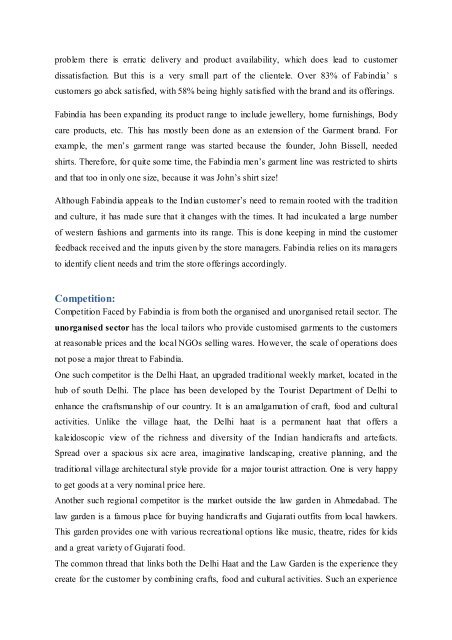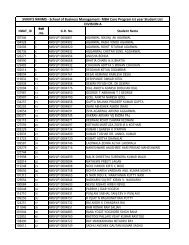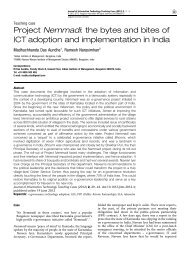Fabindia- Fabric of India - NMIMS
Fabindia- Fabric of India - NMIMS
Fabindia- Fabric of India - NMIMS
Create successful ePaper yourself
Turn your PDF publications into a flip-book with our unique Google optimized e-Paper software.
problem there is erratic delivery and product availability, which does lead to customer<br />
dissatisfaction. But this is a very small part <strong>of</strong> the clientele. Over 83% <strong>of</strong> <strong>Fabindia</strong>’ s<br />
customers go abck satisfied, with 58% being highly satisfied with the brand and its <strong>of</strong>ferings.<br />
<strong>Fabindia</strong> has been expanding its product range to include jewellery, home furnishings, Body<br />
care products, etc. This has mostly been done as an extension <strong>of</strong> the Garment brand. For<br />
example, the men’s garment range was started because the founder, John Bissell, needed<br />
shirts. Therefore, for quite some time, the <strong>Fabindia</strong> men’s garment line was restricted to shirts<br />
and that too in only one size, because it was John’s shirt size!<br />
Although <strong>Fabindia</strong> appeals to the <strong>India</strong>n customer’s need to remain rooted with the tradition<br />
and culture, it has made sure that it changes with the times. It had inculcated a large number<br />
<strong>of</strong> western fashions and garments into its range. This is done keeping in mind the customer<br />
feedback received and the inputs given by the store managers. <strong>Fabindia</strong> relies on its managers<br />
to identify client needs and trim the store <strong>of</strong>ferings accordingly.<br />
Competition:<br />
Competition Faced by <strong>Fabindia</strong> is from both the organised and unorganised retail sector. The<br />
unorganised sector has the local tailors who provide customised garments to the customers<br />
at reasonable prices and the local NGOs selling wares. However, the scale <strong>of</strong> operations does<br />
not pose a major threat to <strong>Fabindia</strong>.<br />
One such competitor is the Delhi Haat, an upgraded traditional weekly market, located in the<br />
hub <strong>of</strong> south Delhi. The place has been developed by the Tourist Department <strong>of</strong> Delhi to<br />
enhance the craftsmanship <strong>of</strong> our country. It is an amalgamation <strong>of</strong> craft, food and cultural<br />
activities. Unlike the village haat, the Delhi haat is a permanent haat that <strong>of</strong>fers a<br />
kaleidoscopic view <strong>of</strong> the richness and diversity <strong>of</strong> the <strong>India</strong>n handicrafts and artefacts.<br />
Spread over a spacious six acre area, imaginative landscaping, creative planning, and the<br />
traditional village architectural style provide for a major tourist attraction. One is very happy<br />
to get goods at a very nominal price here.<br />
Another such regional competitor is the market outside the law garden in Ahmedabad. The<br />
law garden is a famous place for buying handicrafts and Gujarati outfits from local hawkers.<br />
This garden provides one with various recreational options like music, theatre, rides for kids<br />
and a great variety <strong>of</strong> Gujarati food.<br />
The common thread that links both the Delhi Haat and the Law Garden is the experience they<br />
create for the customer by combining crafts, food and cultural activities. Such an experience










